Child Development Report: Activities for Early Childhood Development
VerifiedAdded on 2020/05/16
|15
|2644
|58
Report
AI Summary
This report provides a detailed exploration of child development from birth to 5 years of age, covering cognitive, speech, language, communication, physical, social, and emotional domains. It outlines specific activities designed to support development in each area. The cognitive section includes activities like alphabet and numeral identification and direction games to enhance pre-reading, language, numeracy, and spatial processing skills. Speech, language, and communication development are addressed through reading sessions and 'yes or no' games to improve vocabulary and communication skills. Physical development is supported through activities like family walks and pretend play to promote muscle development and coordination. Finally, the social and emotional section focuses on expression games and collaborative storytelling to foster emotional intelligence and social competence. The report emphasizes the importance of these activities in building a strong foundation for future skills and abilities, referencing key research and studies to support its findings. This report is a valuable resource for understanding the multifaceted aspects of child development and practical approaches to support healthy growth.
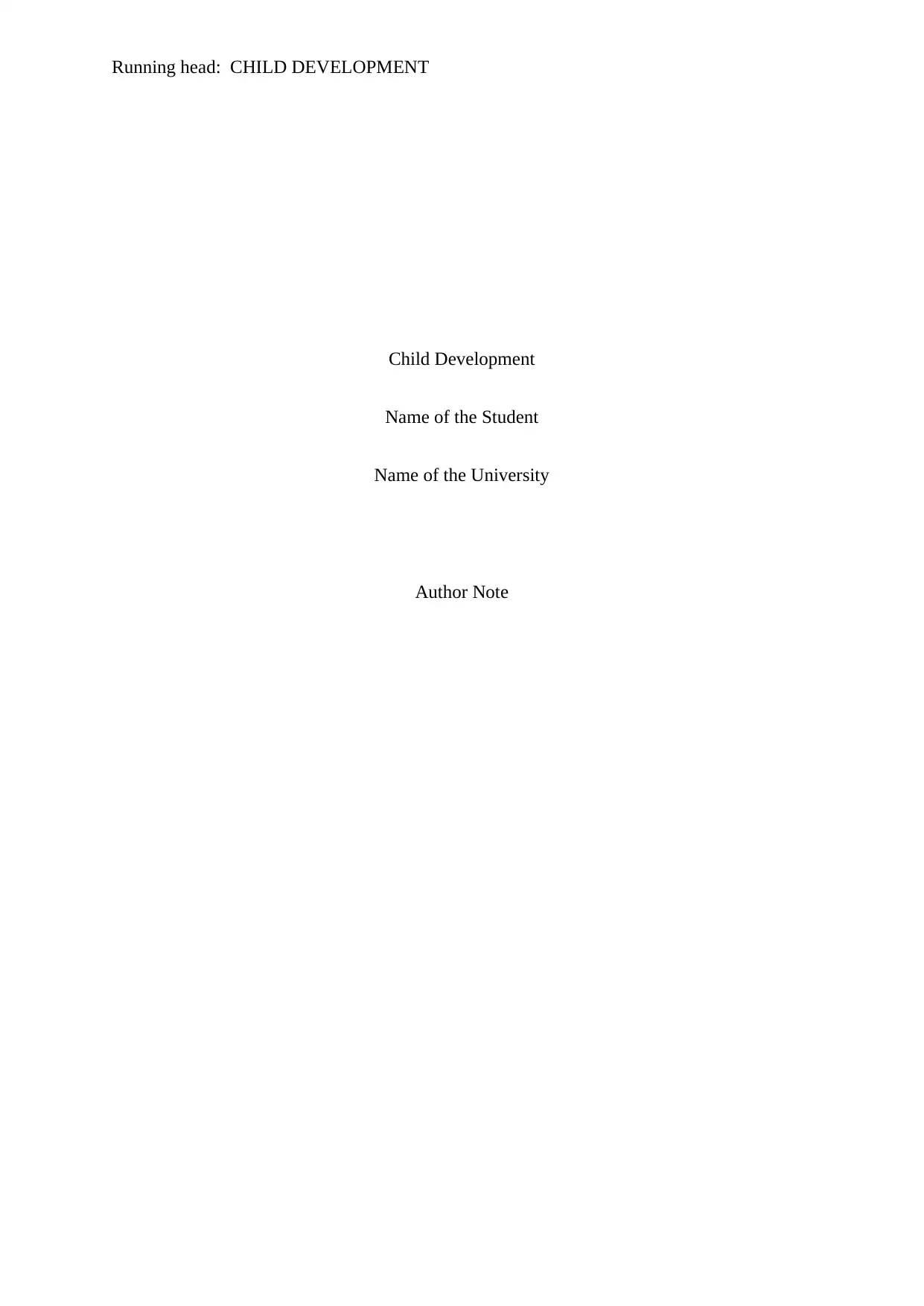
Running head: CHILD DEVELOPMENT
Child Development
Name of the Student
Name of the University
Author Note
Child Development
Name of the Student
Name of the University
Author Note
Paraphrase This Document
Need a fresh take? Get an instant paraphrase of this document with our AI Paraphraser
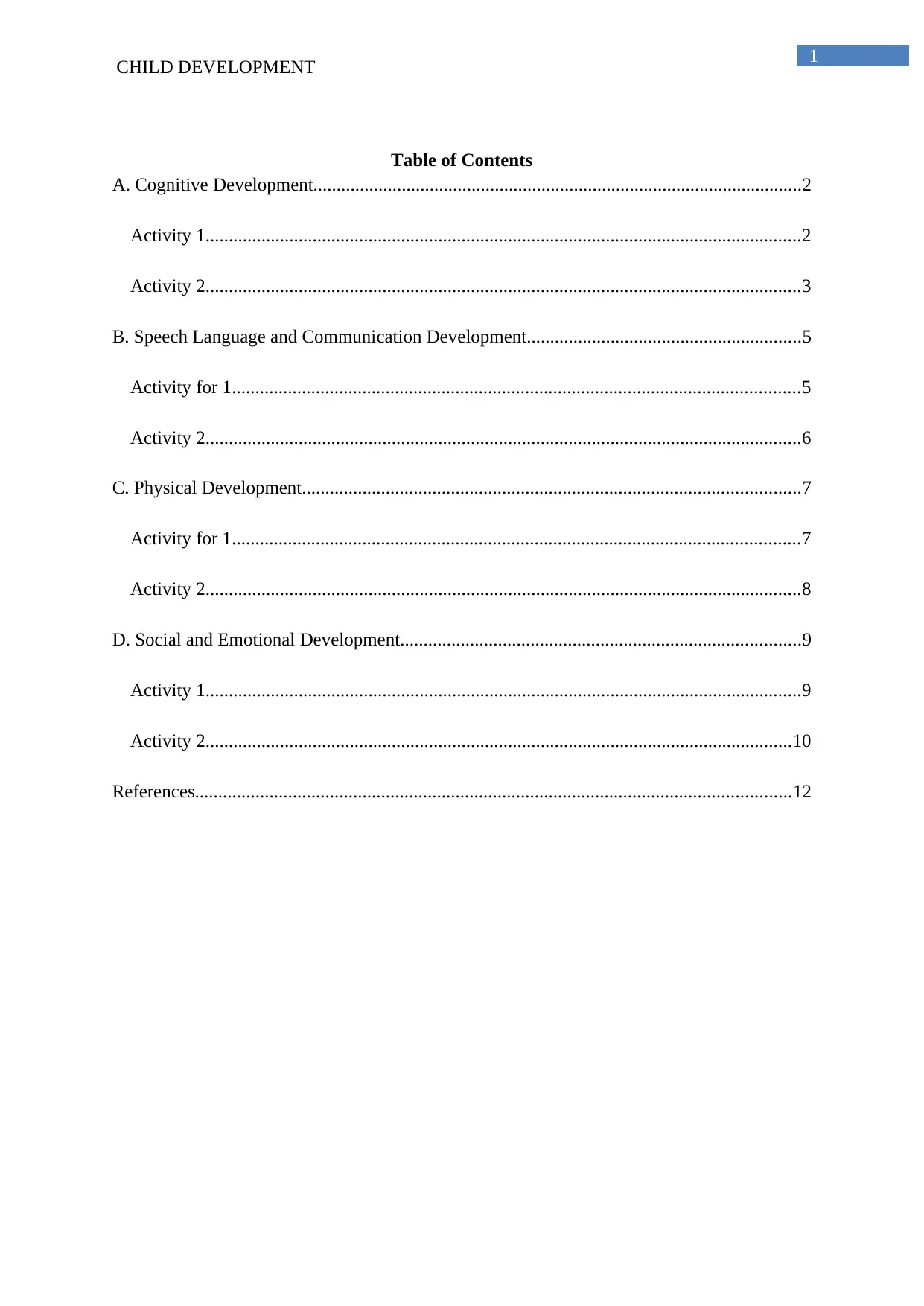
1
CHILD DEVELOPMENT
Table of Contents
A. Cognitive Development.........................................................................................................2
Activity 1................................................................................................................................2
Activity 2................................................................................................................................3
B. Speech Language and Communication Development...........................................................5
Activity for 1..........................................................................................................................5
Activity 2................................................................................................................................6
C. Physical Development...........................................................................................................7
Activity for 1..........................................................................................................................7
Activity 2................................................................................................................................8
D. Social and Emotional Development......................................................................................9
Activity 1................................................................................................................................9
Activity 2..............................................................................................................................10
References................................................................................................................................12
CHILD DEVELOPMENT
Table of Contents
A. Cognitive Development.........................................................................................................2
Activity 1................................................................................................................................2
Activity 2................................................................................................................................3
B. Speech Language and Communication Development...........................................................5
Activity for 1..........................................................................................................................5
Activity 2................................................................................................................................6
C. Physical Development...........................................................................................................7
Activity for 1..........................................................................................................................7
Activity 2................................................................................................................................8
D. Social and Emotional Development......................................................................................9
Activity 1................................................................................................................................9
Activity 2..............................................................................................................................10
References................................................................................................................................12

2
CHILD DEVELOPMENT
CHILD DEVELOPMENT
⊘ This is a preview!⊘
Do you want full access?
Subscribe today to unlock all pages.

Trusted by 1+ million students worldwide
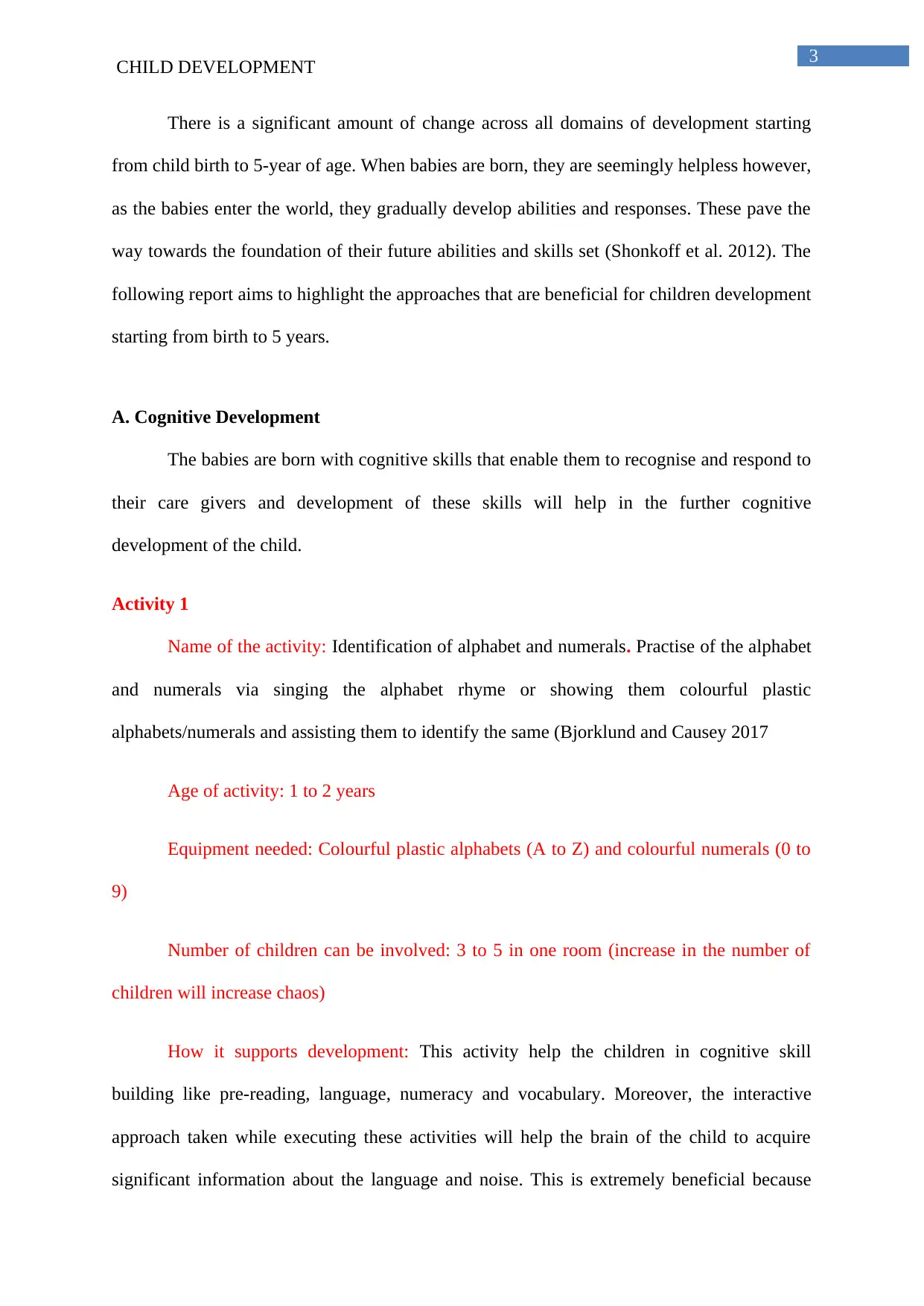
3
CHILD DEVELOPMENT
There is a significant amount of change across all domains of development starting
from child birth to 5-year of age. When babies are born, they are seemingly helpless however,
as the babies enter the world, they gradually develop abilities and responses. These pave the
way towards the foundation of their future abilities and skills set (Shonkoff et al. 2012). The
following report aims to highlight the approaches that are beneficial for children development
starting from birth to 5 years.
A. Cognitive Development
The babies are born with cognitive skills that enable them to recognise and respond to
their care givers and development of these skills will help in the further cognitive
development of the child.
Activity 1
Name of the activity: Identification of alphabet and numerals. Practise of the alphabet
and numerals via singing the alphabet rhyme or showing them colourful plastic
alphabets/numerals and assisting them to identify the same (Bjorklund and Causey 2017
Age of activity: 1 to 2 years
Equipment needed: Colourful plastic alphabets (A to Z) and colourful numerals (0 to
9)
Number of children can be involved: 3 to 5 in one room (increase in the number of
children will increase chaos)
How it supports development: This activity help the children in cognitive skill
building like pre-reading, language, numeracy and vocabulary. Moreover, the interactive
approach taken while executing these activities will help the brain of the child to acquire
significant information about the language and noise. This is extremely beneficial because
CHILD DEVELOPMENT
There is a significant amount of change across all domains of development starting
from child birth to 5-year of age. When babies are born, they are seemingly helpless however,
as the babies enter the world, they gradually develop abilities and responses. These pave the
way towards the foundation of their future abilities and skills set (Shonkoff et al. 2012). The
following report aims to highlight the approaches that are beneficial for children development
starting from birth to 5 years.
A. Cognitive Development
The babies are born with cognitive skills that enable them to recognise and respond to
their care givers and development of these skills will help in the further cognitive
development of the child.
Activity 1
Name of the activity: Identification of alphabet and numerals. Practise of the alphabet
and numerals via singing the alphabet rhyme or showing them colourful plastic
alphabets/numerals and assisting them to identify the same (Bjorklund and Causey 2017
Age of activity: 1 to 2 years
Equipment needed: Colourful plastic alphabets (A to Z) and colourful numerals (0 to
9)
Number of children can be involved: 3 to 5 in one room (increase in the number of
children will increase chaos)
How it supports development: This activity help the children in cognitive skill
building like pre-reading, language, numeracy and vocabulary. Moreover, the interactive
approach taken while executing these activities will help the brain of the child to acquire
significant information about the language and noise. This is extremely beneficial because
Paraphrase This Document
Need a fresh take? Get an instant paraphrase of this document with our AI Paraphraser
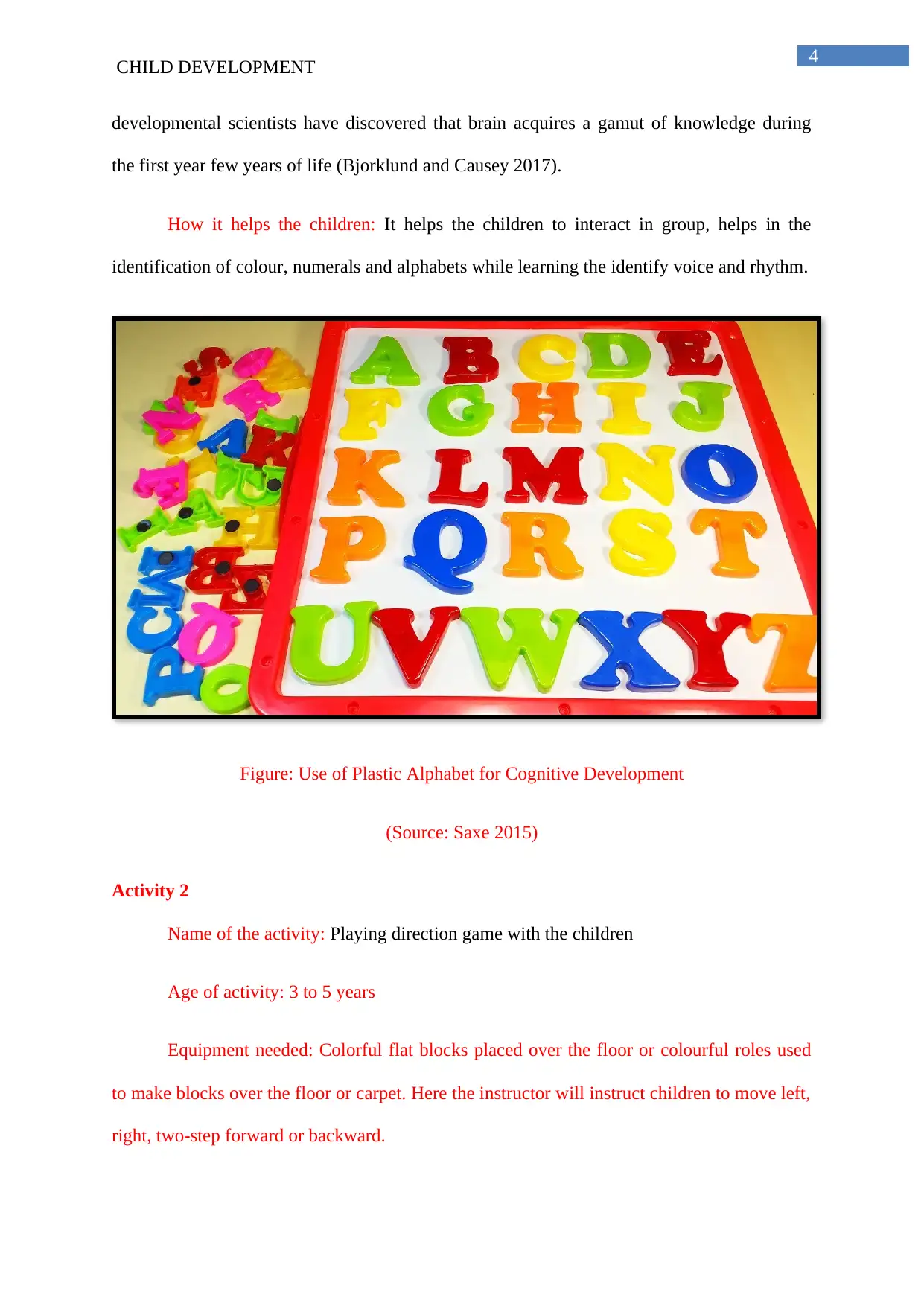
4
CHILD DEVELOPMENT
developmental scientists have discovered that brain acquires a gamut of knowledge during
the first year few years of life (Bjorklund and Causey 2017).
How it helps the children: It helps the children to interact in group, helps in the
identification of colour, numerals and alphabets while learning the identify voice and rhythm.
Figure: Use of Plastic Alphabet for Cognitive Development
(Source: Saxe 2015)
Activity 2
Name of the activity: Playing direction game with the children
Age of activity: 3 to 5 years
Equipment needed: Colorful flat blocks placed over the floor or colourful roles used
to make blocks over the floor or carpet. Here the instructor will instruct children to move left,
right, two-step forward or backward.
CHILD DEVELOPMENT
developmental scientists have discovered that brain acquires a gamut of knowledge during
the first year few years of life (Bjorklund and Causey 2017).
How it helps the children: It helps the children to interact in group, helps in the
identification of colour, numerals and alphabets while learning the identify voice and rhythm.
Figure: Use of Plastic Alphabet for Cognitive Development
(Source: Saxe 2015)
Activity 2
Name of the activity: Playing direction game with the children
Age of activity: 3 to 5 years
Equipment needed: Colorful flat blocks placed over the floor or colourful roles used
to make blocks over the floor or carpet. Here the instructor will instruct children to move left,
right, two-step forward or backward.
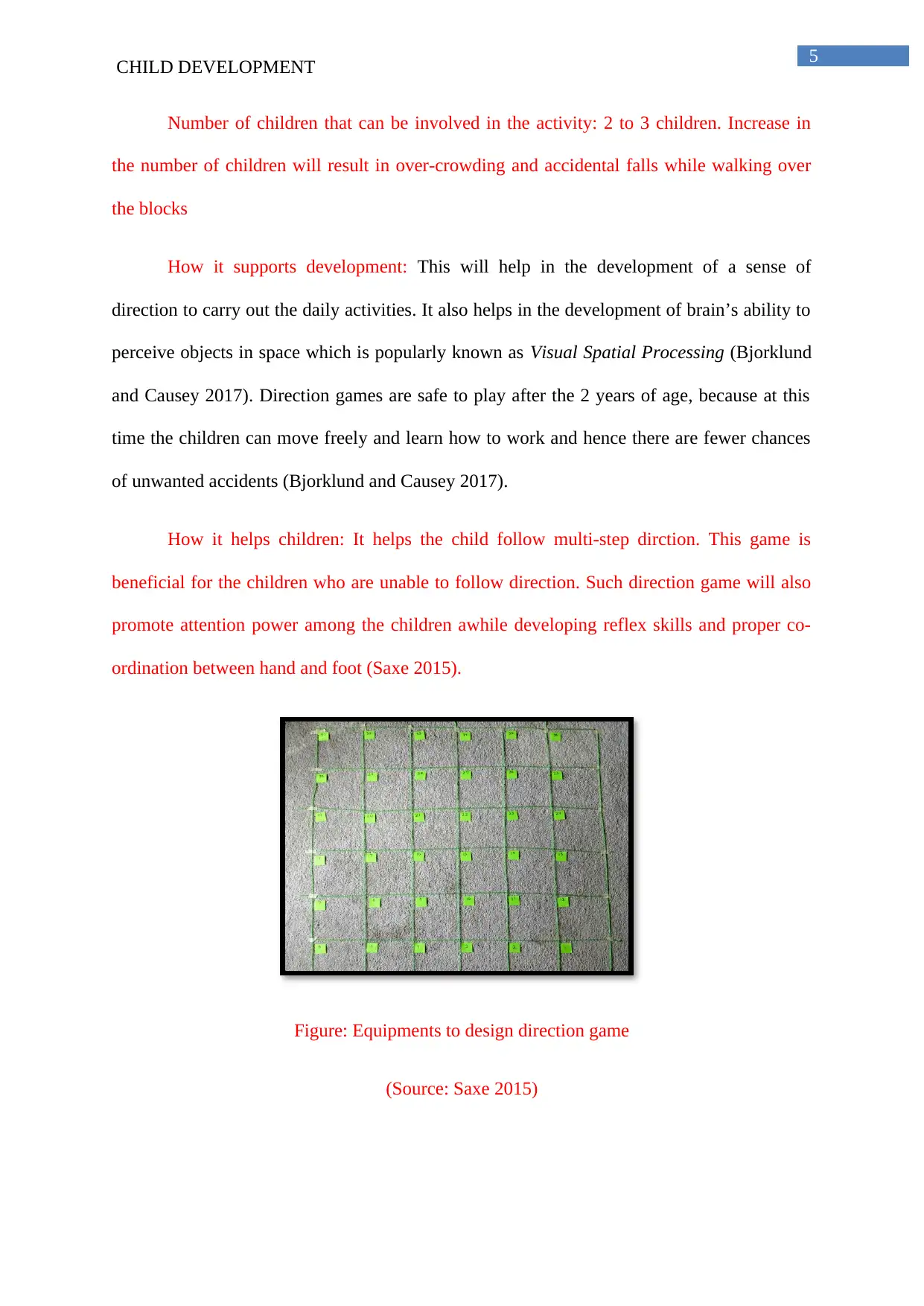
5
CHILD DEVELOPMENT
Number of children that can be involved in the activity: 2 to 3 children. Increase in
the number of children will result in over-crowding and accidental falls while walking over
the blocks
How it supports development: This will help in the development of a sense of
direction to carry out the daily activities. It also helps in the development of brain’s ability to
perceive objects in space which is popularly known as Visual Spatial Processing (Bjorklund
and Causey 2017). Direction games are safe to play after the 2 years of age, because at this
time the children can move freely and learn how to work and hence there are fewer chances
of unwanted accidents (Bjorklund and Causey 2017).
How it helps children: It helps the child follow multi-step dirction. This game is
beneficial for the children who are unable to follow direction. Such direction game will also
promote attention power among the children awhile developing reflex skills and proper co-
ordination between hand and foot (Saxe 2015).
Figure: Equipments to design direction game
(Source: Saxe 2015)
CHILD DEVELOPMENT
Number of children that can be involved in the activity: 2 to 3 children. Increase in
the number of children will result in over-crowding and accidental falls while walking over
the blocks
How it supports development: This will help in the development of a sense of
direction to carry out the daily activities. It also helps in the development of brain’s ability to
perceive objects in space which is popularly known as Visual Spatial Processing (Bjorklund
and Causey 2017). Direction games are safe to play after the 2 years of age, because at this
time the children can move freely and learn how to work and hence there are fewer chances
of unwanted accidents (Bjorklund and Causey 2017).
How it helps children: It helps the child follow multi-step dirction. This game is
beneficial for the children who are unable to follow direction. Such direction game will also
promote attention power among the children awhile developing reflex skills and proper co-
ordination between hand and foot (Saxe 2015).
Figure: Equipments to design direction game
(Source: Saxe 2015)
⊘ This is a preview!⊘
Do you want full access?
Subscribe today to unlock all pages.

Trusted by 1+ million students worldwide
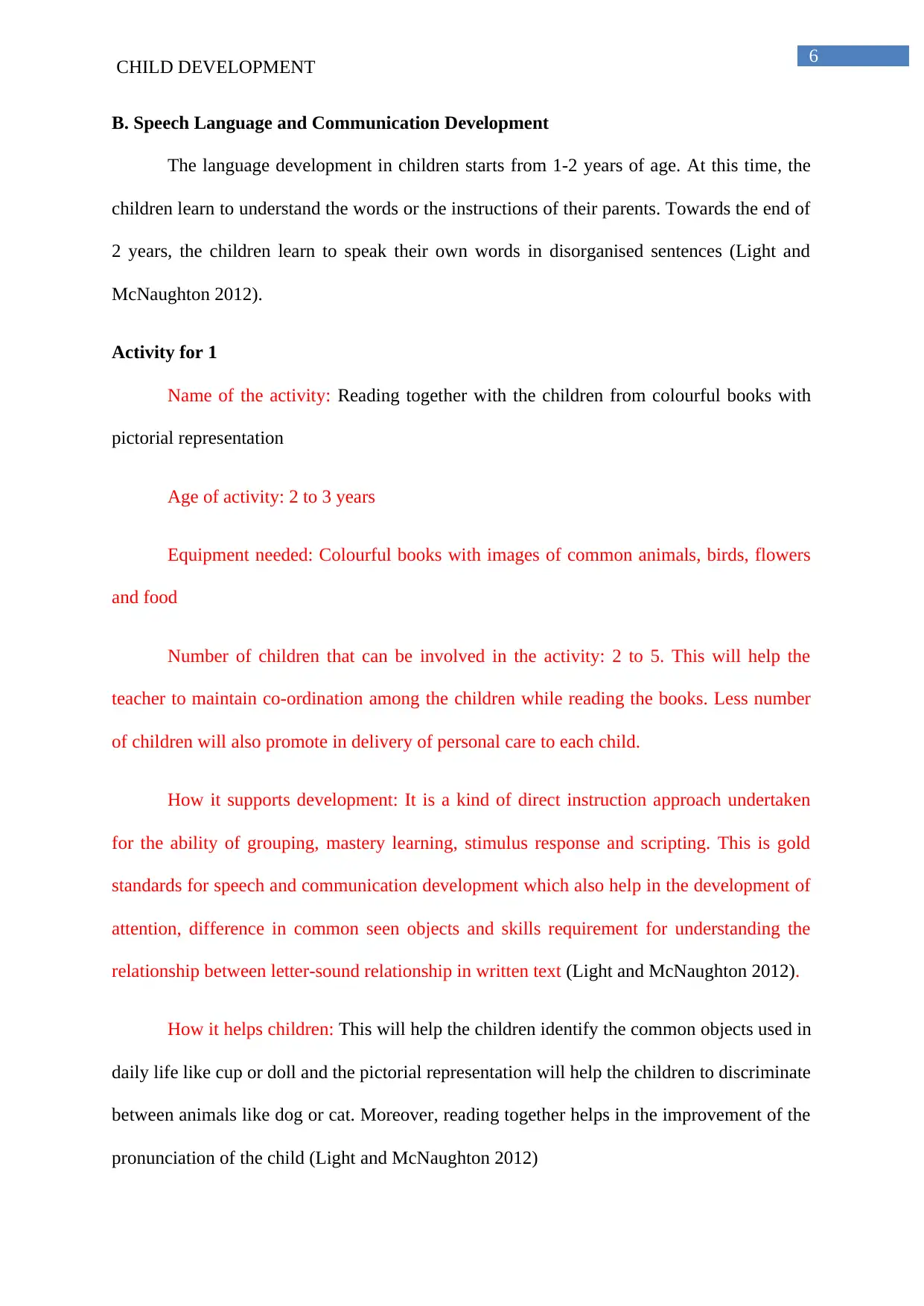
6
CHILD DEVELOPMENT
B. Speech Language and Communication Development
The language development in children starts from 1-2 years of age. At this time, the
children learn to understand the words or the instructions of their parents. Towards the end of
2 years, the children learn to speak their own words in disorganised sentences (Light and
McNaughton 2012).
Activity for 1
Name of the activity: Reading together with the children from colourful books with
pictorial representation
Age of activity: 2 to 3 years
Equipment needed: Colourful books with images of common animals, birds, flowers
and food
Number of children that can be involved in the activity: 2 to 5. This will help the
teacher to maintain co-ordination among the children while reading the books. Less number
of children will also promote in delivery of personal care to each child.
How it supports development: It is a kind of direct instruction approach undertaken
for the ability of grouping, mastery learning, stimulus response and scripting. This is gold
standards for speech and communication development which also help in the development of
attention, difference in common seen objects and skills requirement for understanding the
relationship between letter-sound relationship in written text (Light and McNaughton 2012).
How it helps children: This will help the children identify the common objects used in
daily life like cup or doll and the pictorial representation will help the children to discriminate
between animals like dog or cat. Moreover, reading together helps in the improvement of the
pronunciation of the child (Light and McNaughton 2012)
CHILD DEVELOPMENT
B. Speech Language and Communication Development
The language development in children starts from 1-2 years of age. At this time, the
children learn to understand the words or the instructions of their parents. Towards the end of
2 years, the children learn to speak their own words in disorganised sentences (Light and
McNaughton 2012).
Activity for 1
Name of the activity: Reading together with the children from colourful books with
pictorial representation
Age of activity: 2 to 3 years
Equipment needed: Colourful books with images of common animals, birds, flowers
and food
Number of children that can be involved in the activity: 2 to 5. This will help the
teacher to maintain co-ordination among the children while reading the books. Less number
of children will also promote in delivery of personal care to each child.
How it supports development: It is a kind of direct instruction approach undertaken
for the ability of grouping, mastery learning, stimulus response and scripting. This is gold
standards for speech and communication development which also help in the development of
attention, difference in common seen objects and skills requirement for understanding the
relationship between letter-sound relationship in written text (Light and McNaughton 2012).
How it helps children: This will help the children identify the common objects used in
daily life like cup or doll and the pictorial representation will help the children to discriminate
between animals like dog or cat. Moreover, reading together helps in the improvement of the
pronunciation of the child (Light and McNaughton 2012)
Paraphrase This Document
Need a fresh take? Get an instant paraphrase of this document with our AI Paraphraser
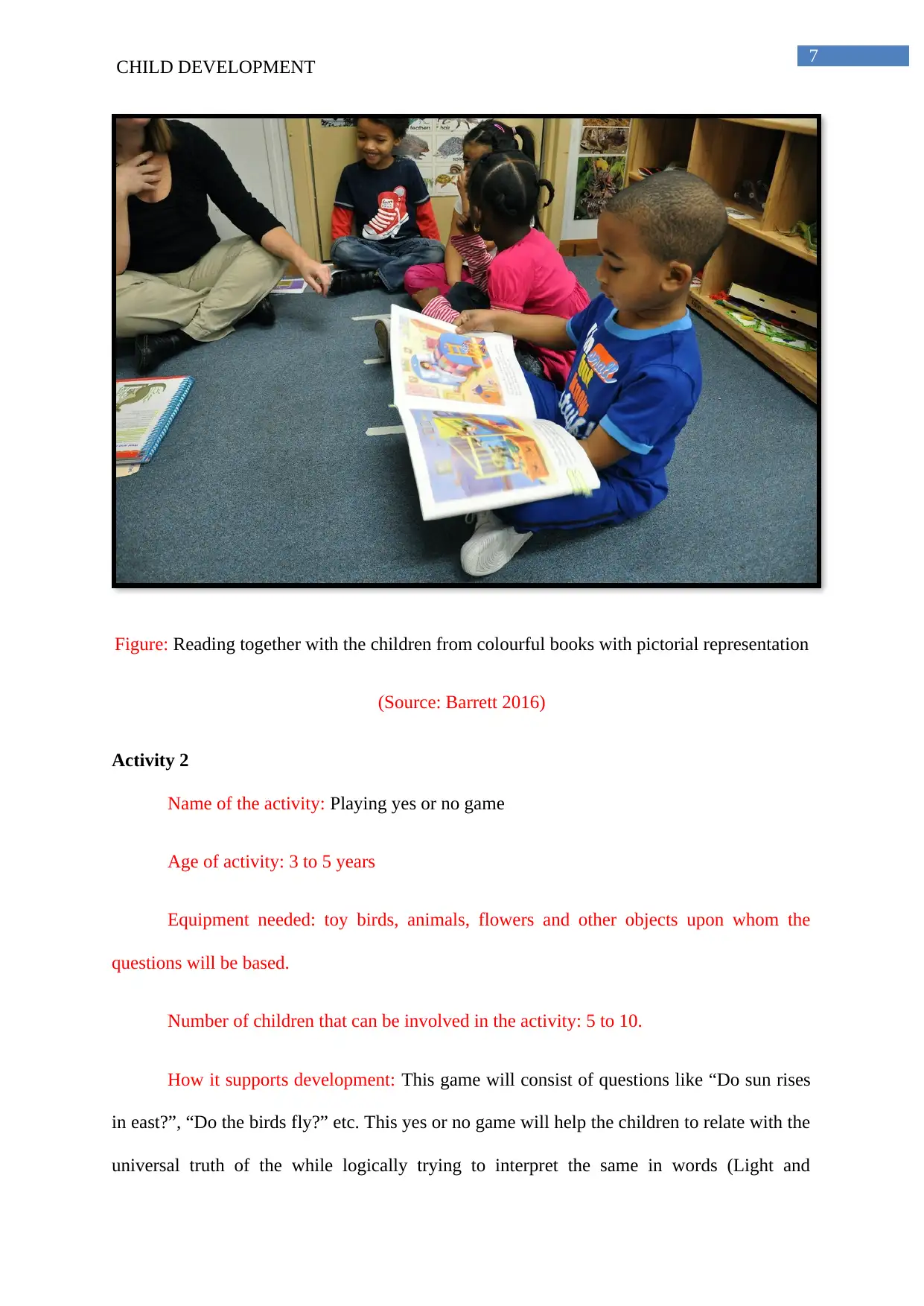
7
CHILD DEVELOPMENT
Figure: Reading together with the children from colourful books with pictorial representation
(Source: Barrett 2016)
Activity 2
Name of the activity: Playing yes or no game
Age of activity: 3 to 5 years
Equipment needed: toy birds, animals, flowers and other objects upon whom the
questions will be based.
Number of children that can be involved in the activity: 5 to 10.
How it supports development: This game will consist of questions like “Do sun rises
in east?”, “Do the birds fly?” etc. This yes or no game will help the children to relate with the
universal truth of the while logically trying to interpret the same in words (Light and
CHILD DEVELOPMENT
Figure: Reading together with the children from colourful books with pictorial representation
(Source: Barrett 2016)
Activity 2
Name of the activity: Playing yes or no game
Age of activity: 3 to 5 years
Equipment needed: toy birds, animals, flowers and other objects upon whom the
questions will be based.
Number of children that can be involved in the activity: 5 to 10.
How it supports development: This game will consist of questions like “Do sun rises
in east?”, “Do the birds fly?” etc. This yes or no game will help the children to relate with the
universal truth of the while logically trying to interpret the same in words (Light and
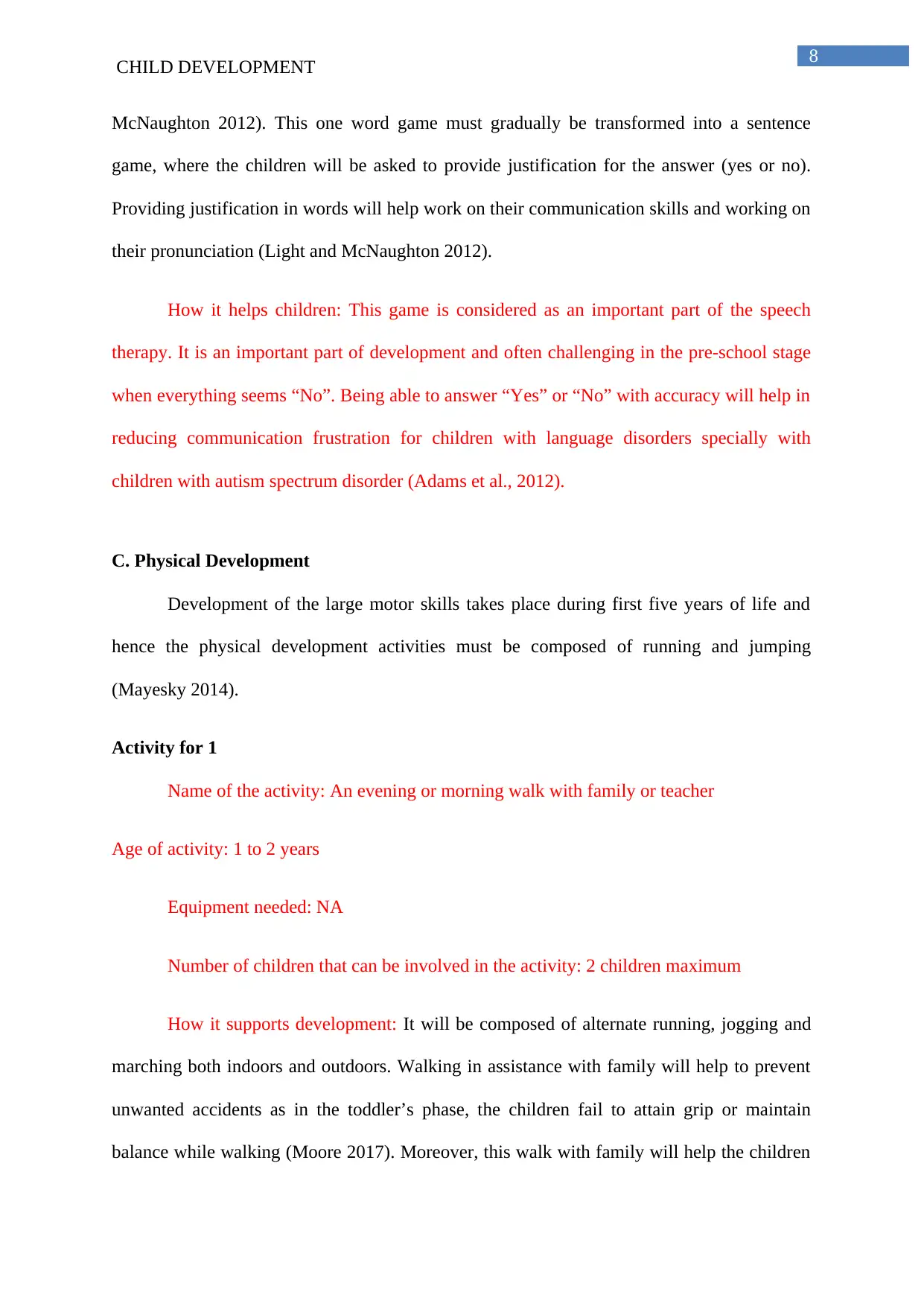
8
CHILD DEVELOPMENT
McNaughton 2012). This one word game must gradually be transformed into a sentence
game, where the children will be asked to provide justification for the answer (yes or no).
Providing justification in words will help work on their communication skills and working on
their pronunciation (Light and McNaughton 2012).
How it helps children: This game is considered as an important part of the speech
therapy. It is an important part of development and often challenging in the pre-school stage
when everything seems “No”. Being able to answer “Yes” or “No” with accuracy will help in
reducing communication frustration for children with language disorders specially with
children with autism spectrum disorder (Adams et al., 2012).
C. Physical Development
Development of the large motor skills takes place during first five years of life and
hence the physical development activities must be composed of running and jumping
(Mayesky 2014).
Activity for 1
Name of the activity: An evening or morning walk with family or teacher
Age of activity: 1 to 2 years
Equipment needed: NA
Number of children that can be involved in the activity: 2 children maximum
How it supports development: It will be composed of alternate running, jogging and
marching both indoors and outdoors. Walking in assistance with family will help to prevent
unwanted accidents as in the toddler’s phase, the children fail to attain grip or maintain
balance while walking (Moore 2017). Moreover, this walk with family will help the children
CHILD DEVELOPMENT
McNaughton 2012). This one word game must gradually be transformed into a sentence
game, where the children will be asked to provide justification for the answer (yes or no).
Providing justification in words will help work on their communication skills and working on
their pronunciation (Light and McNaughton 2012).
How it helps children: This game is considered as an important part of the speech
therapy. It is an important part of development and often challenging in the pre-school stage
when everything seems “No”. Being able to answer “Yes” or “No” with accuracy will help in
reducing communication frustration for children with language disorders specially with
children with autism spectrum disorder (Adams et al., 2012).
C. Physical Development
Development of the large motor skills takes place during first five years of life and
hence the physical development activities must be composed of running and jumping
(Mayesky 2014).
Activity for 1
Name of the activity: An evening or morning walk with family or teacher
Age of activity: 1 to 2 years
Equipment needed: NA
Number of children that can be involved in the activity: 2 children maximum
How it supports development: It will be composed of alternate running, jogging and
marching both indoors and outdoors. Walking in assistance with family will help to prevent
unwanted accidents as in the toddler’s phase, the children fail to attain grip or maintain
balance while walking (Moore 2017). Moreover, this walk with family will help the children
⊘ This is a preview!⊘
Do you want full access?
Subscribe today to unlock all pages.

Trusted by 1+ million students worldwide
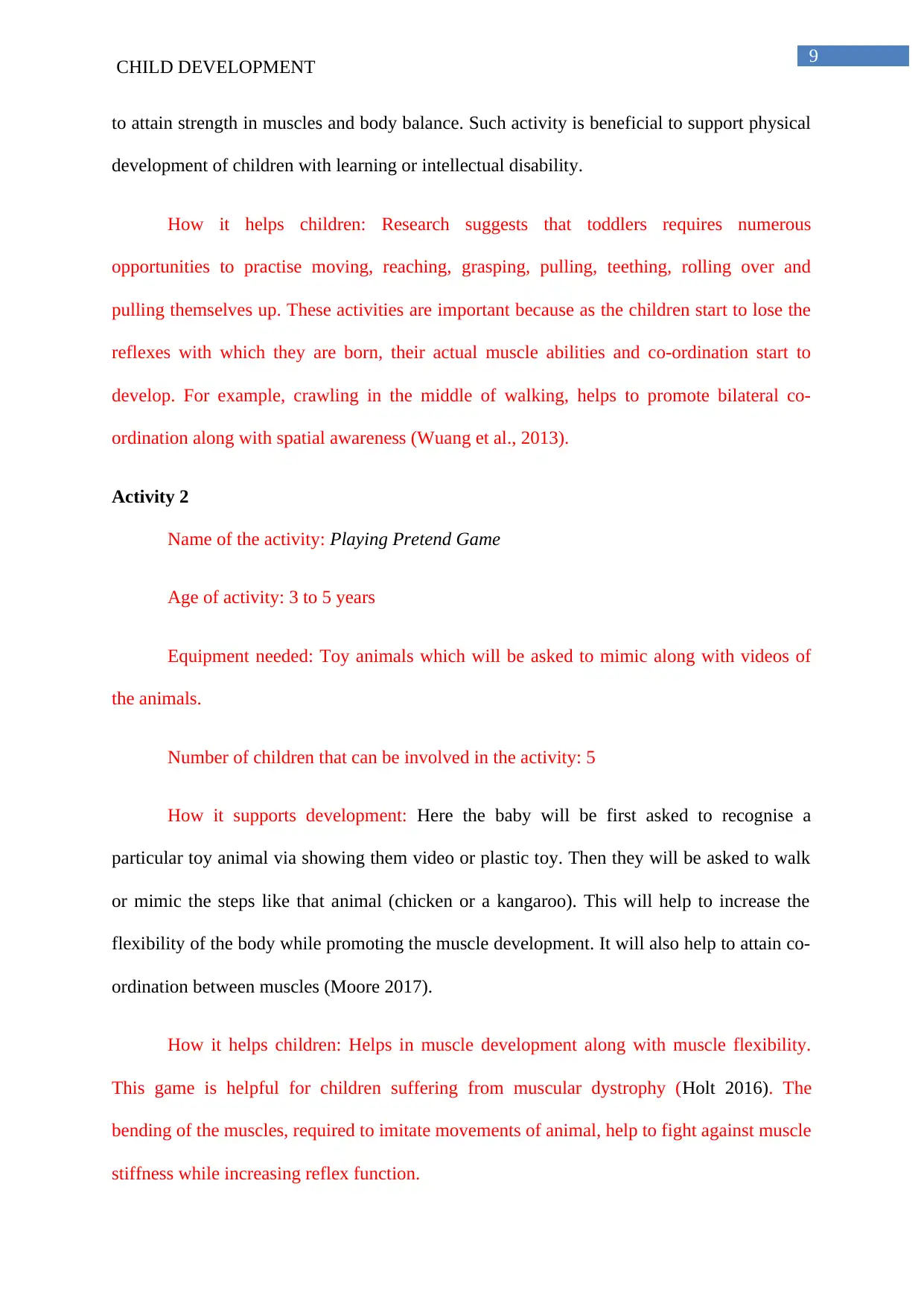
9
CHILD DEVELOPMENT
to attain strength in muscles and body balance. Such activity is beneficial to support physical
development of children with learning or intellectual disability.
How it helps children: Research suggests that toddlers requires numerous
opportunities to practise moving, reaching, grasping, pulling, teething, rolling over and
pulling themselves up. These activities are important because as the children start to lose the
reflexes with which they are born, their actual muscle abilities and co-ordination start to
develop. For example, crawling in the middle of walking, helps to promote bilateral co-
ordination along with spatial awareness (Wuang et al., 2013).
Activity 2
Name of the activity: Playing Pretend Game
Age of activity: 3 to 5 years
Equipment needed: Toy animals which will be asked to mimic along with videos of
the animals.
Number of children that can be involved in the activity: 5
How it supports development: Here the baby will be first asked to recognise a
particular toy animal via showing them video or plastic toy. Then they will be asked to walk
or mimic the steps like that animal (chicken or a kangaroo). This will help to increase the
flexibility of the body while promoting the muscle development. It will also help to attain co-
ordination between muscles (Moore 2017).
How it helps children: Helps in muscle development along with muscle flexibility.
This game is helpful for children suffering from muscular dystrophy (Holt 2016). The
bending of the muscles, required to imitate movements of animal, help to fight against muscle
stiffness while increasing reflex function.
CHILD DEVELOPMENT
to attain strength in muscles and body balance. Such activity is beneficial to support physical
development of children with learning or intellectual disability.
How it helps children: Research suggests that toddlers requires numerous
opportunities to practise moving, reaching, grasping, pulling, teething, rolling over and
pulling themselves up. These activities are important because as the children start to lose the
reflexes with which they are born, their actual muscle abilities and co-ordination start to
develop. For example, crawling in the middle of walking, helps to promote bilateral co-
ordination along with spatial awareness (Wuang et al., 2013).
Activity 2
Name of the activity: Playing Pretend Game
Age of activity: 3 to 5 years
Equipment needed: Toy animals which will be asked to mimic along with videos of
the animals.
Number of children that can be involved in the activity: 5
How it supports development: Here the baby will be first asked to recognise a
particular toy animal via showing them video or plastic toy. Then they will be asked to walk
or mimic the steps like that animal (chicken or a kangaroo). This will help to increase the
flexibility of the body while promoting the muscle development. It will also help to attain co-
ordination between muscles (Moore 2017).
How it helps children: Helps in muscle development along with muscle flexibility.
This game is helpful for children suffering from muscular dystrophy (Holt 2016). The
bending of the muscles, required to imitate movements of animal, help to fight against muscle
stiffness while increasing reflex function.
Paraphrase This Document
Need a fresh take? Get an instant paraphrase of this document with our AI Paraphraser
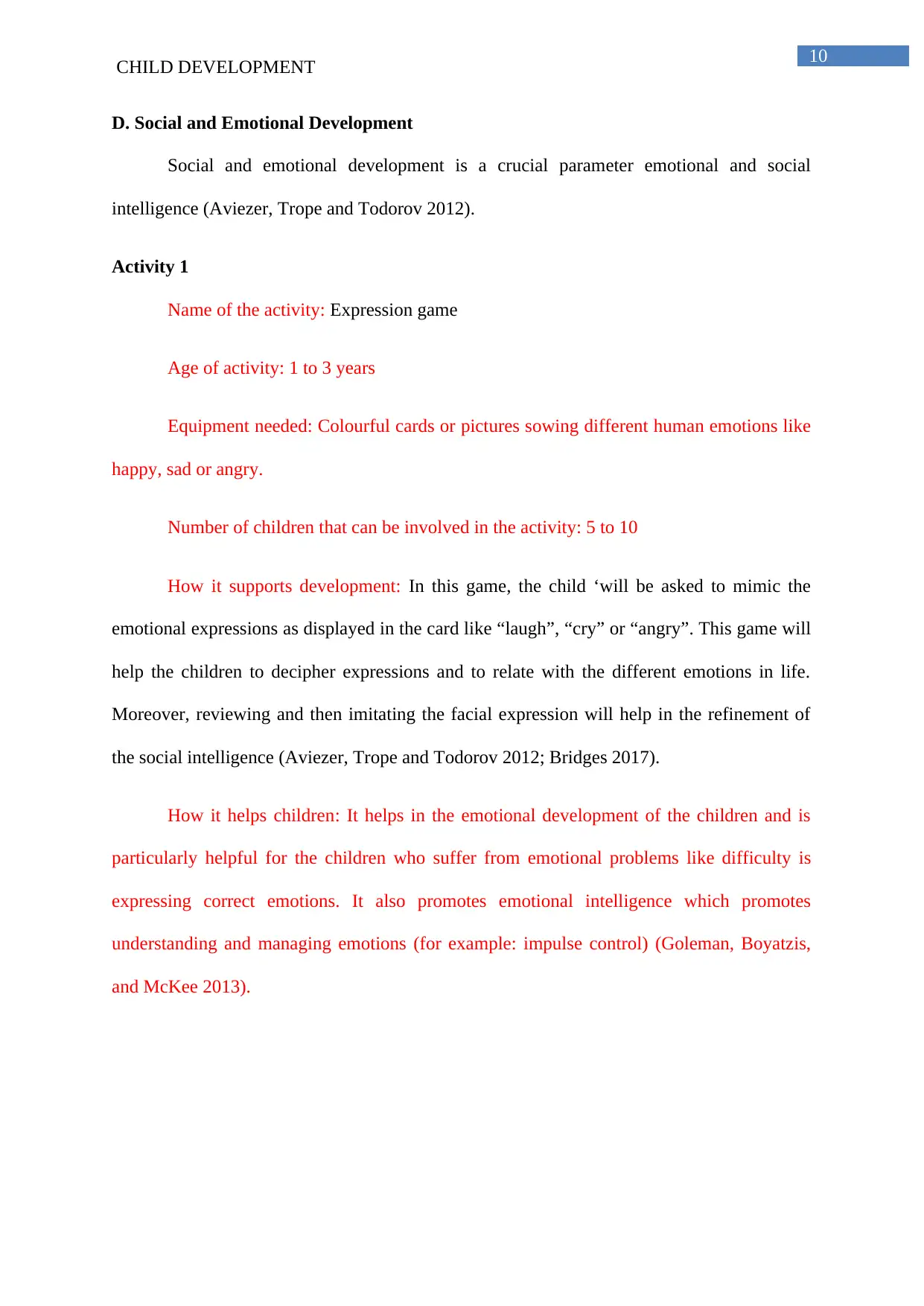
10
CHILD DEVELOPMENT
D. Social and Emotional Development
Social and emotional development is a crucial parameter emotional and social
intelligence (Aviezer, Trope and Todorov 2012).
Activity 1
Name of the activity: Expression game
Age of activity: 1 to 3 years
Equipment needed: Colourful cards or pictures sowing different human emotions like
happy, sad or angry.
Number of children that can be involved in the activity: 5 to 10
How it supports development: In this game, the child ‘will be asked to mimic the
emotional expressions as displayed in the card like “laugh”, “cry” or “angry”. This game will
help the children to decipher expressions and to relate with the different emotions in life.
Moreover, reviewing and then imitating the facial expression will help in the refinement of
the social intelligence (Aviezer, Trope and Todorov 2012; Bridges 2017).
How it helps children: It helps in the emotional development of the children and is
particularly helpful for the children who suffer from emotional problems like difficulty is
expressing correct emotions. It also promotes emotional intelligence which promotes
understanding and managing emotions (for example: impulse control) (Goleman, Boyatzis,
and McKee 2013).
CHILD DEVELOPMENT
D. Social and Emotional Development
Social and emotional development is a crucial parameter emotional and social
intelligence (Aviezer, Trope and Todorov 2012).
Activity 1
Name of the activity: Expression game
Age of activity: 1 to 3 years
Equipment needed: Colourful cards or pictures sowing different human emotions like
happy, sad or angry.
Number of children that can be involved in the activity: 5 to 10
How it supports development: In this game, the child ‘will be asked to mimic the
emotional expressions as displayed in the card like “laugh”, “cry” or “angry”. This game will
help the children to decipher expressions and to relate with the different emotions in life.
Moreover, reviewing and then imitating the facial expression will help in the refinement of
the social intelligence (Aviezer, Trope and Todorov 2012; Bridges 2017).
How it helps children: It helps in the emotional development of the children and is
particularly helpful for the children who suffer from emotional problems like difficulty is
expressing correct emotions. It also promotes emotional intelligence which promotes
understanding and managing emotions (for example: impulse control) (Goleman, Boyatzis,
and McKee 2013).
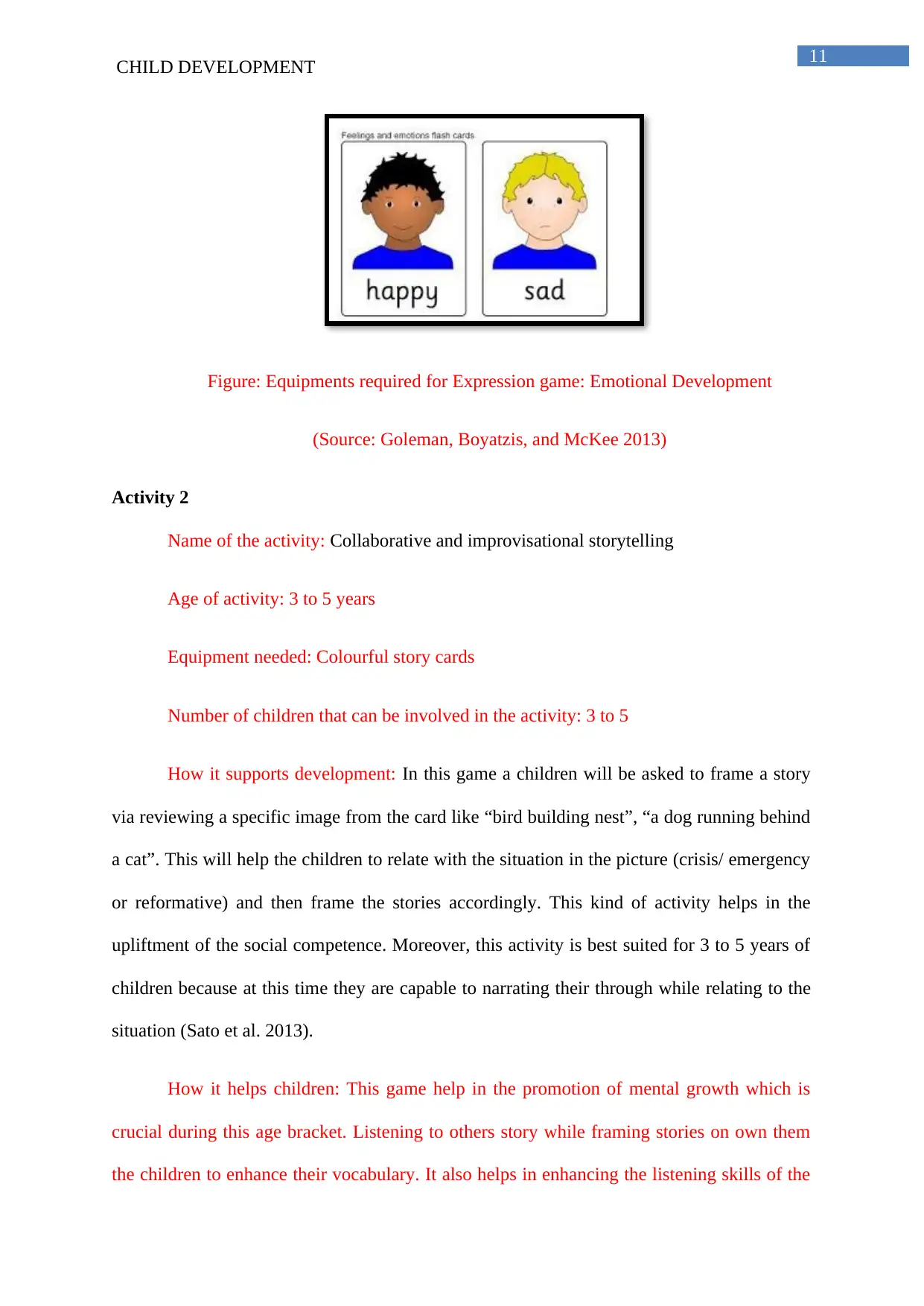
11
CHILD DEVELOPMENT
Figure: Equipments required for Expression game: Emotional Development
(Source: Goleman, Boyatzis, and McKee 2013)
Activity 2
Name of the activity: Collaborative and improvisational storytelling
Age of activity: 3 to 5 years
Equipment needed: Colourful story cards
Number of children that can be involved in the activity: 3 to 5
How it supports development: In this game a children will be asked to frame a story
via reviewing a specific image from the card like “bird building nest”, “a dog running behind
a cat”. This will help the children to relate with the situation in the picture (crisis/ emergency
or reformative) and then frame the stories accordingly. This kind of activity helps in the
upliftment of the social competence. Moreover, this activity is best suited for 3 to 5 years of
children because at this time they are capable to narrating their through while relating to the
situation (Sato et al. 2013).
How it helps children: This game help in the promotion of mental growth which is
crucial during this age bracket. Listening to others story while framing stories on own them
the children to enhance their vocabulary. It also helps in enhancing the listening skills of the
CHILD DEVELOPMENT
Figure: Equipments required for Expression game: Emotional Development
(Source: Goleman, Boyatzis, and McKee 2013)
Activity 2
Name of the activity: Collaborative and improvisational storytelling
Age of activity: 3 to 5 years
Equipment needed: Colourful story cards
Number of children that can be involved in the activity: 3 to 5
How it supports development: In this game a children will be asked to frame a story
via reviewing a specific image from the card like “bird building nest”, “a dog running behind
a cat”. This will help the children to relate with the situation in the picture (crisis/ emergency
or reformative) and then frame the stories accordingly. This kind of activity helps in the
upliftment of the social competence. Moreover, this activity is best suited for 3 to 5 years of
children because at this time they are capable to narrating their through while relating to the
situation (Sato et al. 2013).
How it helps children: This game help in the promotion of mental growth which is
crucial during this age bracket. Listening to others story while framing stories on own them
the children to enhance their vocabulary. It also helps in enhancing the listening skills of the
⊘ This is a preview!⊘
Do you want full access?
Subscribe today to unlock all pages.

Trusted by 1+ million students worldwide
1 out of 15
Related Documents
Your All-in-One AI-Powered Toolkit for Academic Success.
+13062052269
info@desklib.com
Available 24*7 on WhatsApp / Email
![[object Object]](/_next/static/media/star-bottom.7253800d.svg)
Unlock your academic potential
Copyright © 2020–2025 A2Z Services. All Rights Reserved. Developed and managed by ZUCOL.





